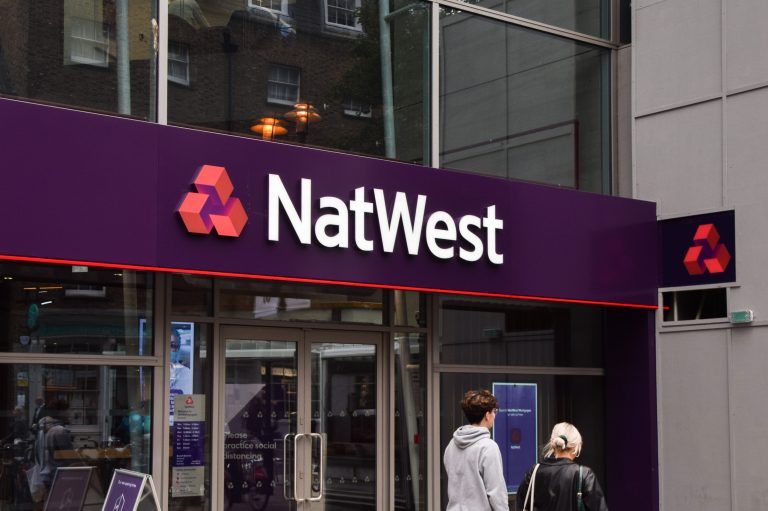With all the distractions that are going on at the boardroom level it’s a relief to be able to focus on the fundamentals when it comes to the NatWest share price.
The share price has lost quite a lot of ground this week falling from 1-month highs last week on the back of the resignation of CEO Alison Rose, as well as disappointment over the results of its sector peers of Barclays and Lloyds.
The reaction to Lloyds Banking Group numbers was especially puzzling given that they raised their NIM guidance for the year despite seeing a fall to 3.14% in Q2.
The main concern in the wake of the Q1 numbers was pressure on margins, as well as higher costs against a backdrop of challenging economic conditions, which prompted the bank to be cautious about its full year guidance which the left unchanged, saying they expected to generate full-year income of £14.8bn, and a full-year NIM of 3.2%, based on a base rate of 4%.
Given that the base rate is likely to remain well above that figure and looks set to move to 5.25% next week this seemed overly cautious at the time.
Today’s Q2 numbers have seen attributable profits to shareholders come in at just over £1bn, a slight fall from the same period last year, as well as being lower than the £1.28bn in Q1, pushing H1 profits up to £2.3bn.
The bank like Lloyds before it also saw net interest margin slip back in Q2 to 3.13%, from 3.27% in Q1, although unlike Lloyds, NatWest have cut their full year forecast to 3.15% from 3.2%, based on the assumption of a Bank of England base rate of 5.5%.
NatWest also said it was planning to buyback another £500m of its own shares, while paying an interim dividend of 5.5p a share.
On the business itself, net loans saw an increase to £352.7bn during the first half of the year, with £5.9bn of that being new mortgage lending, however most of that growth came in Q1.
Customer deposits declined by £11.8bn during the first half, although we did see a modest rise in deposits of £2bn in Q2, as customers put money back into their accounts as the bank raised savings rates to help stop the outflow. These higher rates have been reflected in the total income numbers in the retail banking unit which saw Q2 total income fall sharply from the levels we saw in Q1.
This increased competition for customer deposits helps explain the fall in NIM as the savings landscape becomes more competitive. This is likely to cap the upside for NIM, however it is also important to remember that NIM is still higher at 3.2% than it was a year ago when it was at 2.58%
The bank added another £153m in respect of non-performing loans in Q2 to add to the £70m it added in Q1.
All in all, today’s results have come in pretty much in line with its peers earlier this week, however investors will be looking to ensure that recent events around the departure of CEO Alison Rose, and as well as the departure of the Coutts CEO Peter Flavel, are brought to a swift conclusion.
There is a concern that the uncertainty around current events will prove a distraction to senior management, and there are also serious questions to answer around the judgement of chairman Howard Davies who thought that the conduct of outgoing CEO Alison Rose did not merit a stricter sanction.
Trust and confidence in banking are a key pillar when it comes to banking relationships with client confidentiality at the core of it.
You can be sure that if a similar situation had occurred with a more junior member of staff the sanction would have been more severe, and while no-one would question Alison Rose’s role in leading the bank over the past few years, no-one is above being held to account when it comes to GDPR and rules of the code of conduct. It seems odd that Howard Davies failed to realise this, and Rose’s subsequent resignation casts serious doubt over his judgement.
While Davies has maintained that his intention is to remain as Chairman in this morning’s earnings call, citing the confidence of main shareholders and the regulators, it is hard to see how he can.
It’s quite likely that in order to restore confidence in the management of the bank, pressure could well grow for him to step down in the coming days.
Disclaimer: CMC Markets is an execution-only service provider. The material (whether or not it states any opinions) is for general information purposes only, and does not take into account your personal circumstances or objectives. Nothing in this material is (or should be considered to be) financial, investment or other advice on which reliance should be placed. No opinion given in the material constitutes a recommendation by CMC Markets or the author that any particular investment, security, transaction or investment strategy is suitable for any specific person. The material has not been prepared in accordance with legal requirements designed to promote the independence of investment research. Although we are not specifically prevented from dealing before providing this material, we do not seek to take advantage of the material prior to its dissemination.

